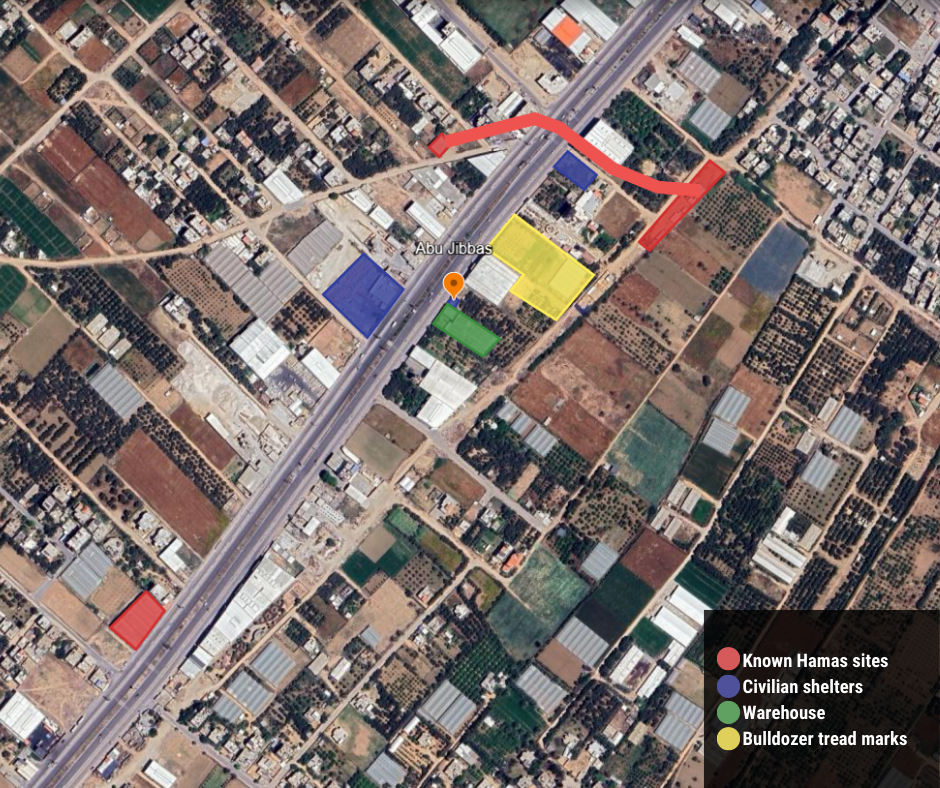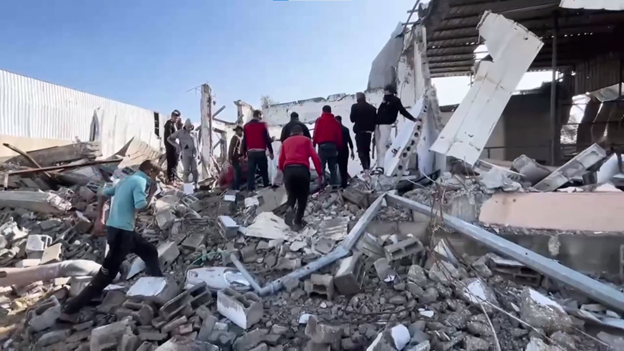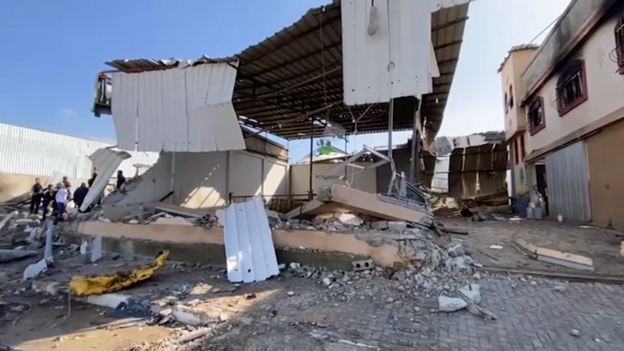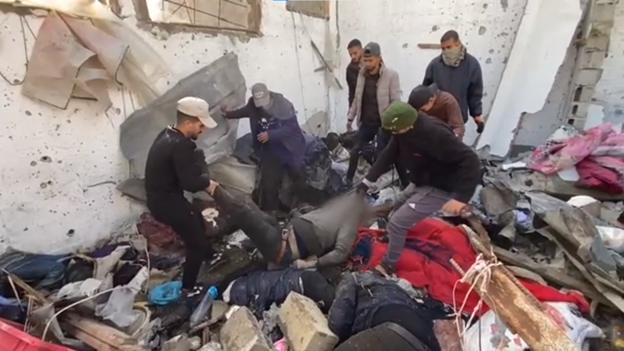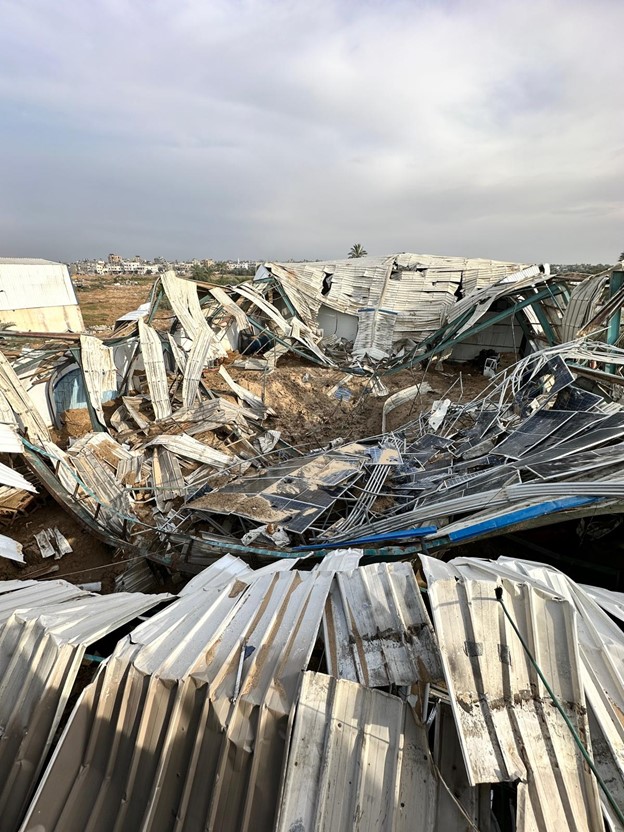Over the course of the ongoing war launched by Hamas on October 7, there has been a growing trend of CNN reporters making shocking factual allegations based on thin evidence. Unchecked by journalistic standards, some of these reporters have moved past making dubious factual allegations to making dubious legal conclusions based on them. Instead of acting as journalists, they are acting as both prosecutor and judge.
Such is the case in the February 28 article, “How indiscriminate Israeli fire killed half a family in Gaza” by Abeer Salman, Mohammad Al Sawalhi, Benjamin Brown, Mick Krever, Jomana Karadsheh, Ivana Kottasová, Gianluca Mezzofiore, Carlotta Dotto, Byron Manley, and Lou Robinson.
The story has to do with the alleged bombing of a warehouse that resulted in eight dead – including five members of the Abu Jibba family – in what the authors declare was an “indiscriminate” bombing and an “atrocity.” That is, they aren’t just reporting facts; they are declaring that those facts amount to a legal conclusion which the authors deem themselves competent to make.
This makes it all the more important to thoroughly analyze CNN’s reporting.
But, as has repeatedly been the case in CNN articles, the story is riddled with factual errors and misleading narratives. In some cases, the facts reported by CNN itself contradict the journalists’ conclusions.
This analysis will begin by focusing on the main factual allegations regarding the presence, or lack thereof, of terrorists in the vicinity, and whether the IDF knew, or should have known, that the building was being used as a shelter. Following that is a review of some of the ways in which the authors mislead about the facts and the law of armed conflict.
The Facts
Before laying out the facts, it is necessary to elaborate on the question of which facts matter, given that the story accuses the IDF of what amounts to a war crime. In determining whether a military strike violated the law of armed conflict (LOAC), the important question isn’t whether civilians died, but rather what the commander knew, or reasonably should have known, at the time of the strike. As explained by LOAC experts Geoffrey S. Corn and Lt. Gen. (Ret.) Robert P. Ashley, the tendency to issue “effects-based” condemnations “fundamentally distorts the LOAC equation for assessing attack legality, an equation that focuses on the attack judgment and not the attack effect. The law demands that those judgments be reasonable under the existing circumstances, not that they always be right.”
To make such an allegation in a responsible way, the reporters must be able to demonstrate that they thoroughly reviewed all available evidence, including both inculpatory and exculpatory information. Given the gravity of the allegation, the evidence should be substantial. To make such serious allegations based on flimsy evidence would be, as CAMERA has pointed out before, equivalent to tabloid journalism.
The Alleged Facts
So what is the evidence presented that suggests an “atrocity?”
The authors allege that on January 4, eight Gazans, including five from the Abu Jibba family, were killed by the IDF in a warehouse located on Salah a-Din Road, near the towns of Maghazi, Deir al-Balah, and Zawayda. Citing “experts,” the authors argue that the crater at the site suggests a 2,000-pound bomb was used, and that it is consistent with one that “detonated on impact.” However, according to CNN’s main witness, at least “several” were killed at the scene by gunfire shortly before the bombing. In a statement given to CNN, the IDF reportedly explained that its forces were taking gunfire from that location, and the strike was carried out to address that threat.
The reporters write that, “Eyewitnesses said there were no militants inside the warehouses where they were sheltering, and that they weren’t aware of Hamas operating in the area.” Sumaya Abu Jibba, the mother, also claimed that they had “put up white flags” and wrote “displaced families” on the building. Sumaya also claims that “Israeli drones and planes were constantly flying overhead, monitoring the area.” CNN also asserts, based on the claims of the witnesses, that the Gazans were never told to evacuate the area.
Given this is the main evidence CNN provides to suggest the IDF committed an “atrocity,” it is worth going through each of the individual allegations. Are any of these allegations contradicted elsewhere in CNN’s own reporting? Is there available open-source information contradicting some of the claims? Are there any reasonable alternative interpretations of the facts presented?
Was Hamas Operating in the Area?
Whether Hamas and/or other Palestinian terrorists were operating in the vicinity of the warehouse is a crucial question. The claim that the IDF engaged in “indiscriminate” bombing largely rests on this fact, for if terrorists were operating in the vicinity, that would substantially raise the likelihood that the IDF’s version of events is accurate and that the IDF was not bombing anyone and anything, but was trying to target terrorists.
It’s thus notable that CNN’s claim that “eyewitnesses” said “they weren’t aware of Hamas operating in the area” of the warehouse is flatly false, based on the network’s own reporting.
The authors themselves cite a witness, Hamed al-Hinnawi, who was staying in a building directly across the street from the warehouse, who said he heard “resistance fire” that morning. Al-Hinnawi told CNN that he decided to flee “west, away from the fiercest fighting” with his family. Notably, the warehouse in which the Abu Jibba family was located was to Al-Hinnawi’s east.
The article also briefly acknowledges that “local journalists” reported “clashes” in the area that day, but this understates the evidence.
Consider one detail hidden in CNN’s reporting, seemingly aimed at depicting the IDF as indiscriminate: the allegation that an UNRWA warehouse “located just up the road” from the warehouse was hit by two tank shells on the same day. Omitted, however, is that Hamas itself announced that morning that it had attacked an “Israeli Merkava tank” to the “west of al-Maghazi.” The warehouse in question is located west, and slightly to the south, of al-Maghazi.
CNN reported claims of IDF tank fire in the vicinity, but omitted that Hamas itself was boasting of its presence in the area and of having attacked Israeli tanks.
The timing of this report fits with the incident at the warehouse, too. One of CNN’s witnesses, Alaa Abu Jibba, put the timeline of the IDF operations at the warehouse as “from 4 a.m. to 1 p.m.” The Hamas announcement about attacking an Israeli tank went out around noon, based on the near simultaneous posting by the Hamas-affiliated Safa news agency and the Hamas-linked Hassan Eslayeh, whom CNN itself has used in the past.
Other reports and video of clashes between the IDF and Palestinian terrorists in the area were also posted during this time period. Quds News posted reports of “clashes” in the area multiple times during this period, including at 7:07a.m. and 8:25a.m. At 4:15a.m., Quds News even posted video, reportedly filmed from the Shomar Factory in al-Maghazi, which is “just up the road” from the warehouse, in which the sounds of a loud gun battle can be heard. That day, Al-Ghad TV also reported battles and the use of smoke shells – used to screen ground forces from enemy fire – in the area.
But the evidence of the presence of Palestinian terrorists in the vicinity gets even stronger.
As CNN itself admits, the warehouse was built on the same section of Salah a-Din Road in which the IDF found Hamas’s main weapons manufacturing complex which stretched nearly two kilometers from al-Bureij and Nuseirat nearly all the way to Deir al-Balah.
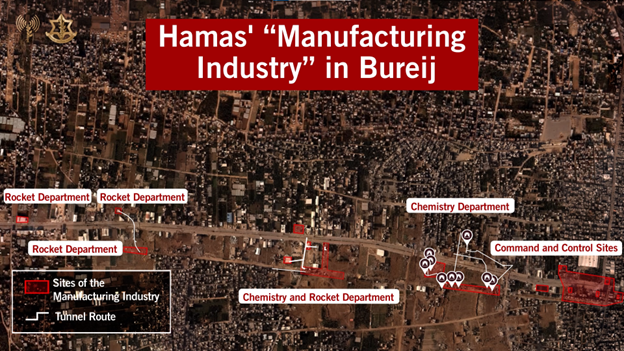
Source: IDF
The complex was built in four different centers. The warehouse was located in one of those centers, which the IDF termed the “rocket department.” In other words, the warehouse sat in the middle of one of Hamas’s most strategically important sites in Gaza.
Provided below are two images to help get a sense of the proximity of these Hamas sites to where the Abu Jibbas were staying. First is a map showing the locations of the various sites in question. The second image is a still from a video published by the IDF showing the demolition of the Hamas terror tunnel in which the warehouse in question can be seen.
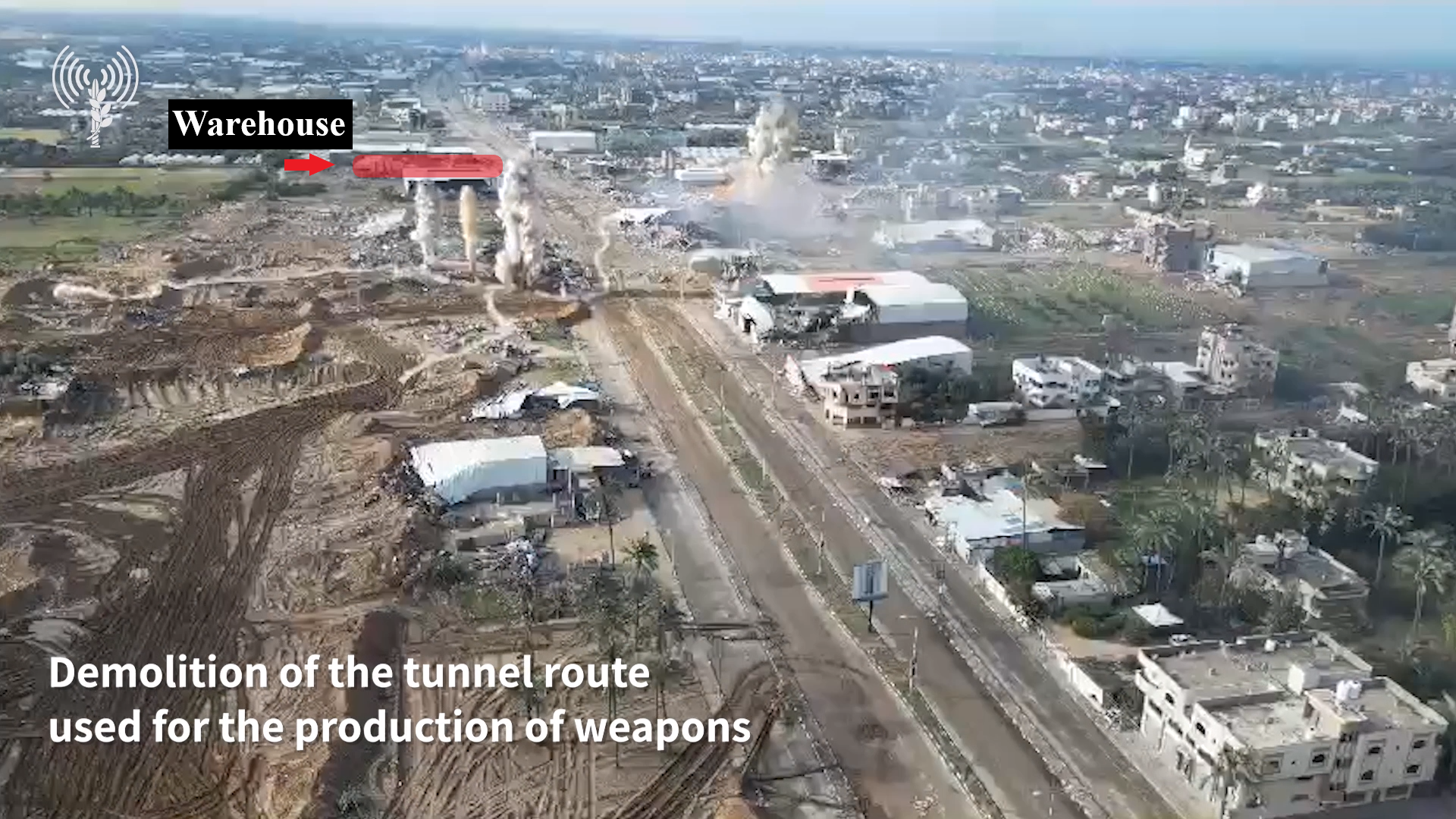
Source: IDF
The warehouse was plainly located in close proximity to these strategic Hamas sites, which have been documented with footage and even toured by independent journalists. One of the tunnel shafts exposed by the IDF was located around 175 meters away from the warehouse.
To reach the conclusion that Hamas was not operating in the vicinity, and thus the IDF committed an “indiscriminate” attack, the authors had to ignore CNN’s own witness, numerous media reports, and the claims of Hamas itself. On top of that, CNN would have to believe that Hamas did not put up a fight at one of its most strategic sites in the Gaza Strip.
The Warehouse
Now consider a key question: were there any terrorists in the warehouse itself? Despite how central this question is to CNN’s assertion that an “atrocity” was carried out by the IDF, the evidence presented is shockingly thin.
In support of this conclusion, the authors produce only one piece of evidence: “Eyewitnesses said there were no militants inside the warehouses where they were sheltering.” But the IDF directly contradicted this, saying its forces were fired upon from that location. This raises the question of why CNN chose to believe one side, but not the other. This becomes more puzzling given that there is strong circumstantial evidence that Hamas was operating in the immediate vicinity.
But even beyond the evidence of Hamas in the area, there are several reasons to question the reliability of the claims made by CNN’s eyewitnesses. In particular, it is not clear that these “eyewitnesses” were actually in a position to know what was happening in the warehouse.
Consider, for example, that two of CNN’s named witnesses were not even in the warehouse. One, al-Hinnawi, was sheltering at a ceramic and tile factory across the street. It’s also not clear whether or not he had fled by the time the warehouse was bombed. It’s further unclear where exactly another named witness, Alaa Abu Jibba, was at the time of the incident. The only place CNN identifies him being is in a field in which displaced Gazans had set up tents approximately 200 meters away from the warehouse.
But it’s also unclear whether those located at the warehouse actually could have known what was happening in the warehouse. After all, CNN clearly states that they were staying not in the warehouse itself, but in a warehouse annex. Based on some of CNN’s own footage, it appears that the annex was a distinct, separate part of the building, and that there was at least one wall between the Abu Jibba family and the part of the warehouse that was apparently hit by the bomb.
This raises the question of how those staying in the “annex” knew, or could have known, that terrorists were not operating in the part of the warehouse struck. The authors mention they sent an “extensive set of questions” to the IDF, but did they pose a similarly extensive set of questions to those at the warehouse? Thorough questioning would help tease out these details and any potential inconsistencies in the statements of those witnesses. If the reporters did not engage in thorough questioning to ensure they were getting all these details, why not? This is a basic, but crucial, question. If they did ask about this, what did the witnesses say?
Similarly, on the subject of unaddressed questions and whether terrorists were located in the warehouse, there is the issue of who three of the eight bodies belonged to. Only five names, all siblings from the Abu Jibba family, ages 10-22, are identified among the eight. Among those five is Hamdi Abu Jibba, age 22, who, according to his mother Sumaya, was killed by gunfire shortly before the warehouse was bombed.
CNN leaves unexplained who the other three bodies belonged to, giving only a few clues. Sumaya told CNN that “several others” were killed by gunfire alongside Hamdi moments before the alleged airstrike. We’re also told that among the bodies at the scene, there were “several adults curled up.” Indeed, three adult-sized bodies can be seen in a video provided by CNN which, based on appearances and attire, belonged to men.
Consider this information. Hamdi, a military-aged male, and “several others” – presumably the three bodies unidentified by CNN but consistent with military-aged males – were killed by gunfire shortly before the bombing, which the IDF said was carried out in response to gunfire from the location.
Does CNN know the identity of the others killed in the warehouse? Did the reporters look into this question? Did they ask the surviving members of the Abu Jibba family who else was staying with them in that small warehouse annex? Surely the reporters could have figured it out. The article mentions they obtained records from the hospital where the bodies were taken.
Given these unaddressed questions about the reliability of the evidence presented, it’s deeply irresponsible for CNN to level the accusation against the IDF without further investigation.
White Flags, Writing on the Building, and Drones
Another key question is whether the IDF knew, or should have known, that the warehouse was being used as a civilian shelter.
In fact, there’s a question of whether the warehouse annex was a significant shelter at all. The authors never say how many were sheltering there, not even an approximation. Footage suggests the warehouse annex was a relatively small space that would not have been able to accommodate more than a dozen or so. It seems safe to say that no one was staying in the main part of the warehouse, given that the only bodies referenced are those found in the annex. Notably, this raises its own questions as to why no one was staying in the main part of the warehouse. With all of that space, one wonders why so many displaced Gazans were forced to pitch tents in an open field down the road instead of under the roof of the warehouse. Once again, it’s unclear if the reporters considered and probed this question.
On the other hand, the ceramics and tile factory across the street was sheltering approximately 95 displaced Gazans, according to the article. It’s not difficult to understand how any reasonable aerial observer might mistake civilians in the vicinity as staying in the much more prominent, visible factory shelter, without realizing the small annex building across the street was also being used.
Which brings us to the claim made by just one witness, Sumaya Abu Jibba, that the words “displaced persons” were written on the building, that white flags were displayed, and that IDF drones had been observing the area for a while.
Yet again, there are several crucial, but answered, questions about this claim
First, where were the white flags displayed? Where did they write “displaced persons” on the building? Did they write it on the roof? Which roof? The warehouse roof, or the annex roof? What did they write with? How large was the text? Was it in a prominent color? Sumaya says “the families” wrote the text on the building, and yet the only family mentioned in the warehouse annex was the Abu Jibba family. Was she perhaps referring to families staying at the ceramics and tile factory across the street?
Indeed, what matters most is not whether the writing and flags existed, but whether they would have been reasonably visible. Yet we’re given zero details about this question.
This is especially curious because the authors make extensive use of satellite imagery. Assuming the writing was directed toward the drones Sumaya mentioned, one wonders whether such writing might have been visible on the rooftop. Does any satellite imagery show the writing? On that note, why do the dates of satellite imagery CNN reference not include imagery for the crucial dates of January 1-4, the days leading up to the incident and the day of the incident itself?
Relatedly, could any trace of the writing be found on the remains of the warehouse? CNN’s footage of the aftermath shows that the roof, while collapsed, appears in relatively clean condition.
Even if there were writing and white flags, and even if they were prominently displayed, were they visible in the conditions existing at the time of the incident? One of CNN’s witnesses, al-Hinnawi, recounted that when he escaped from the shelter across the street, “there was so much smoke that when he looked down, he couldn’t see the fingers on his hands.” If al-Hinnawi couldn’t see his own fingers, could the IDF have reasonably seen any writing on the building?
This is not nitpicking. CNN has alleged, in conclusive terms, that the IDF committed an “atrocity.” This particular question – whether there were visible markings indicating the building was a civilian shelter – is crucial when it comes to determining whether a crime was committed in this instance. This is a basic question that the journalists should have asked and thoroughly examined before making such an allegation.
It’s also worth noting that even if there were writing on the building, and even if an IDF drone saw it at some point prior to the incident, the IDF has indicated the airstrike was not a pre-planned operation in which the commander had time to review all available intelligence, but rather an urgent strike made in the chaos of combat. Israeli soldiers were being fired upon. The commander was expected to act reasonably given the existing circumstances, not based on perfect conditions with all the time in the world to review intelligence.
Does the Evidence Stack Up?
Given all these inconsistencies, open questions, and contradictory evidence, consider what the authors had to do to reach the conclusion they did: that the IDF “indiscriminately” bombed the warehouse, committing an “atrocity.”
The authors needed to disregard the IDF’s statement in its entirety. They also needed to disregard several statements by their own witness, al-Hinnawi. They similarly needed to disregard the abundant evidence of Palestinian terrorists operating in the vicinity around the time of the incident. They needed to assume that even though the warehouse was built in the middle of one of Hamas’s most important strategic sites, the terrorist organization was not operating in the vicinity.
Meanwhile, the authors needed to assume everything that Sumaya Abu Jibba said was entirely accurate. On top of that, they needed to make unsupported assumptions about Sumaya’s claims, such as that the writing on the building she mentions was clearly visible. They also needed to assume that the witnesses in the warehouse annex were in a position to know what was happening in the warehouse itself, notwithstanding there appears to have been a wall between the annex and the warehouse.
This is not the behavior of impartial journalists interested in the truth. To the contrary, the lack of curiosity into the unaddressed questions suggests a disinterest in truth-seeking.
Instead, this is the behavior of partisan activists who seek to paint one party to a conflict in the most unforgiving light possible.
Misleading on the Facts
Beyond making horrendous conclusions based on flimsy evidence, several factual errors in the report raise some concerns about the story.
Perhaps most telling is the authors’ references to distances.
Consider these two sentences in the article:
- “The nearby tent encampment is gone – replaced by military vehicles, tracks, and bulldozed earth. Israeli military vehicles can be seen about 213 feet away from the warehouse.”
- “According to the map, a building just 250 meters (820 feet) northeast of the warehouse where the Abu Jibba family was staying was used by Hamas for weapons manufacturing.”
In fact, the tent encampment, where the Israeli military vehicles were seen, is approximately 200 meters away from the warehouse, or approximately 800 feet, based on Google Maps.
For context, returning to the color-coded map, the tent encampment is the blue area to the northeast of the Abu Jibba marker. Meanwhile, the “building just 250 meters (820) feet northeast of the warehouse” is the red area to the east of the tent encampment. Clearly, the authors erred, and in doing so, overstated how close Israeli military vehicles were to the warehouse.
Worse, the authors deceived their audience about how close the known Hamas sites were to the warehouse. The “building just 250 meters (820 feet) northeast of the warehouse” was connected, by a terror tunnel, to another building being used by Hamas for weapons manufacturing which was only about 175 meters north of the warehouse. That is, the authors used the building further away in such a way that misleads the audience about how close Hamas’s infrastructure was to the warehouse.
The authors also perniciously imply that the IDF used bulldozers to bury the displaced Gazans in the warehouse. They quote one of the witnesses saying, “They left us in the room and started bulldozing, and then bombs started falling on us.” They then immediately quote the IDF as saying “allegations of shooting at civilians who were sheltering in the area or any trampling of civilians with the help of bulldozers or any other vehicle are baseless.”
But CNN’s own satellite imagery seems to disprove that any bulldozers were used on the warehouse. The imagery shows what appear to be some type of tracks next to the building to the warehouse’s north, but never approaching closer than approximately 50 meters.
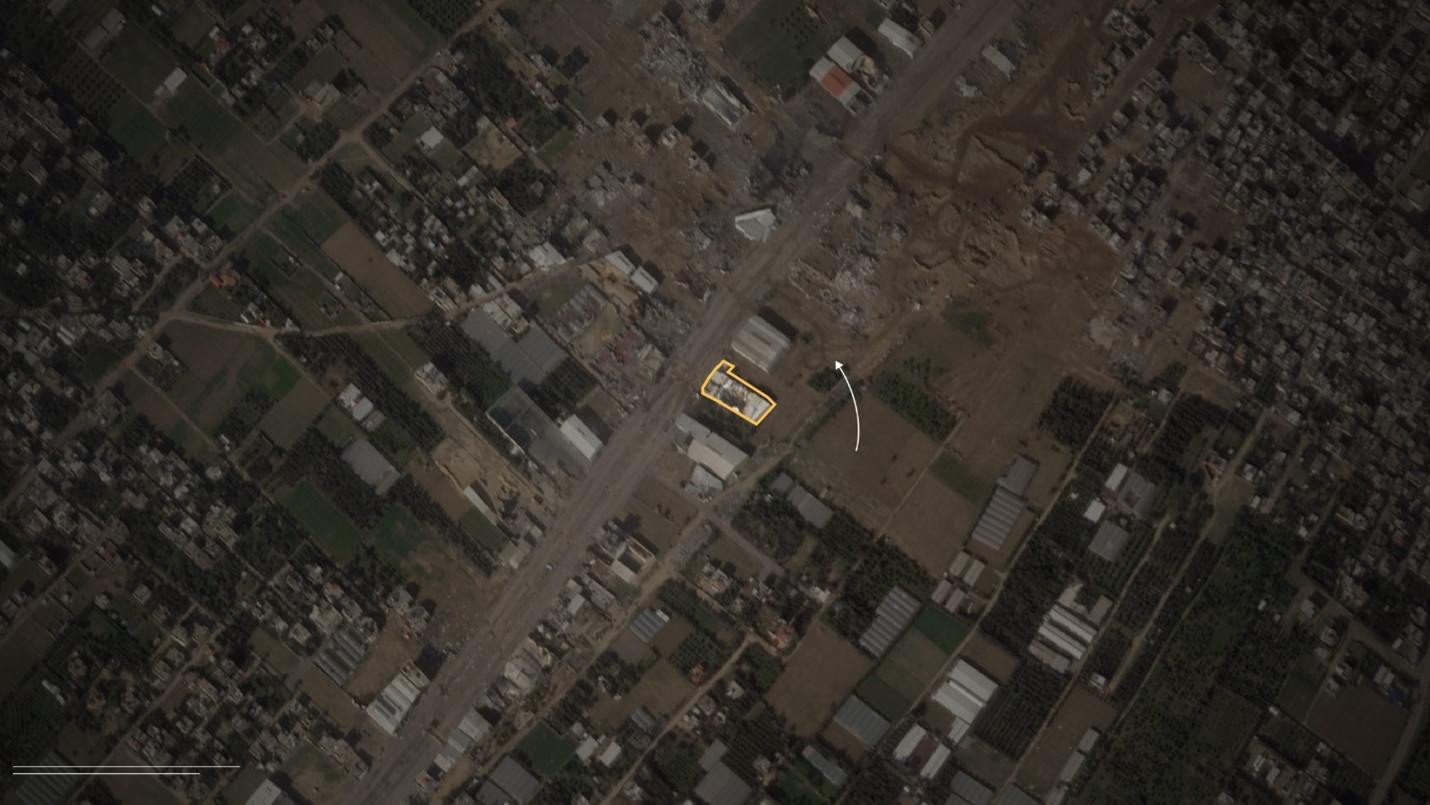
An image used by CNN to show the location of what it alleges are bulldozer tracks near the warehouse.
The inclusion of these quotes, once again, seems designed to imply cruelty on the part of the IDF, which is unsupported by the actual evidence.
Meanwhile, it’s worth also pointing out the game CNN is playing with its “expert” witnesses. To support its claim that the damage was caused by a “2,000-pound bomb,” the authors turned to three organizations, Human Rights Watch, Amnesty International, and PAX. All three are notorious for their anti-Israel activism. But what is especially notable is that the individual “experts” from the first two organizations are clearly identified (Mark Hiznay and Brian Castner), whereas no individual is specifically mentioned from PAX. The likely explanation is that the individual was the expert from PAX that CNN has repeatedly turned to before, the avid Nazi memorabilia collector Marc Garlasco, who is notorious for making blatantly false claims about Israel, as has been repeatedly documented by CAMERA.
It appears that CNN is sufficiently embarrassed about being exposed for turning to someone as notorious as Garlasco, and yet refuses to give up turning to the biased “expert” the journalists know will give them the expert testimony they want to hear.
Misleading on the Law
In addition to getting the facts wrong, the authors also get the law wrong in such a way that undermines their conclusions.
Consider this passage from the article:
International humanitarian law protects civilians in armed conflict and requires attacking forces to warn civilians of planned attacks if possible. Under the principle of proportionality enshrined in the UN charter, warring parties should not use more force than is needed to respond to a threat. The testimonies collected by CNN and imagery of the damage to the building raise serious questions about whether the IDF made any efforts to avoid harm to civilians, and the proportionality of the attack.
Where to begin?
First, there is no “principle of proportionality” enshrined in the UN Charter, and second, the authors are confusing two different concepts.
It seems that the authors are referring to the right of self-defense, which is enshrined in the UN Charter, and which forms a part of what is known as jus ad bellum, which deals with the law of resorting to war, and which does involve a principle of proportionality.
However, that principle of proportionality has nothing to do with individual strikes. Rather, this principle of proportionality provides that a state engaging in a war in self-defense must “limit defensive force to that required to defeat the armed attack and likely follow-on attacks.” It deals with how much force Israel is allowed to use to defeat Hamas, not how much force it is allowed to use in any individual strike.
When discussing the “proportionality of the attack” on the warehouse, however, an entirely different principle of proportionality is used under the law of armed conflict. Under this principle, commanders are instructed to assess an attack which may be expected to cause incidental harm to civilians, and to decide whether the military advantage anticipated from the attack justifies that incidental harm.
That is, not only did CNN rely on thin and contradictory evidence to accuse Israel of having committed a war crime, or an “atrocity” as they put it, they even used the wrong legal principle to judge the IDF.
If CNN can’t be relied upon to produce an accurate picture of the facts, or to give the proper analysis of those facts, then can CNN be relied upon as a serious journalistic entity at all?

